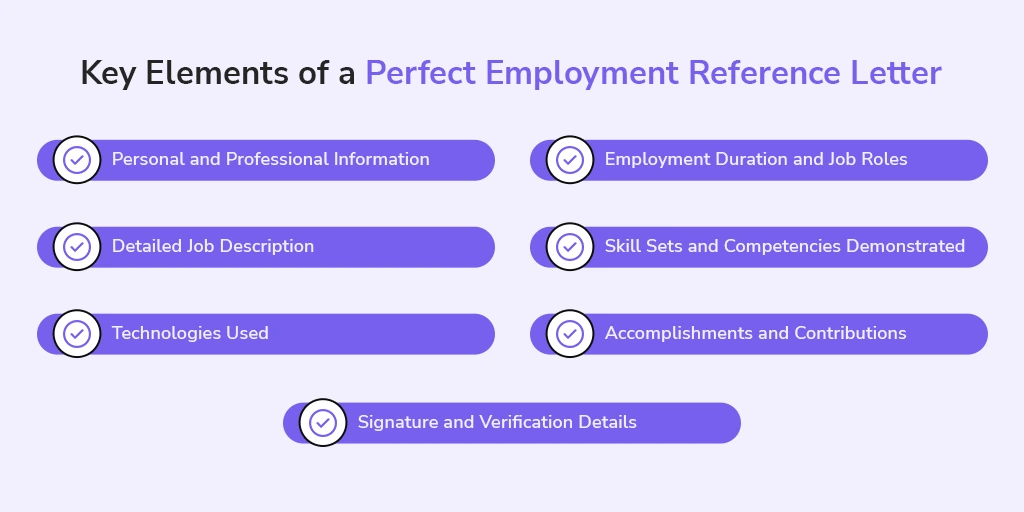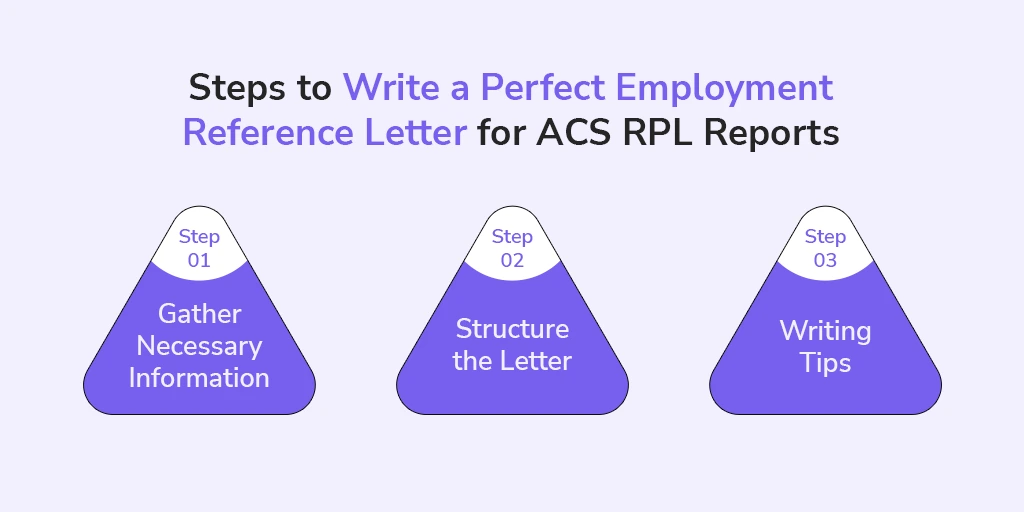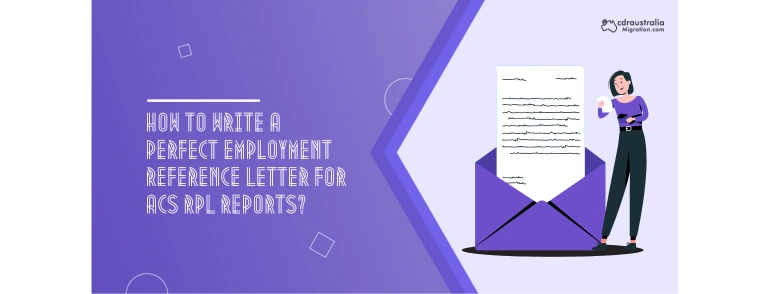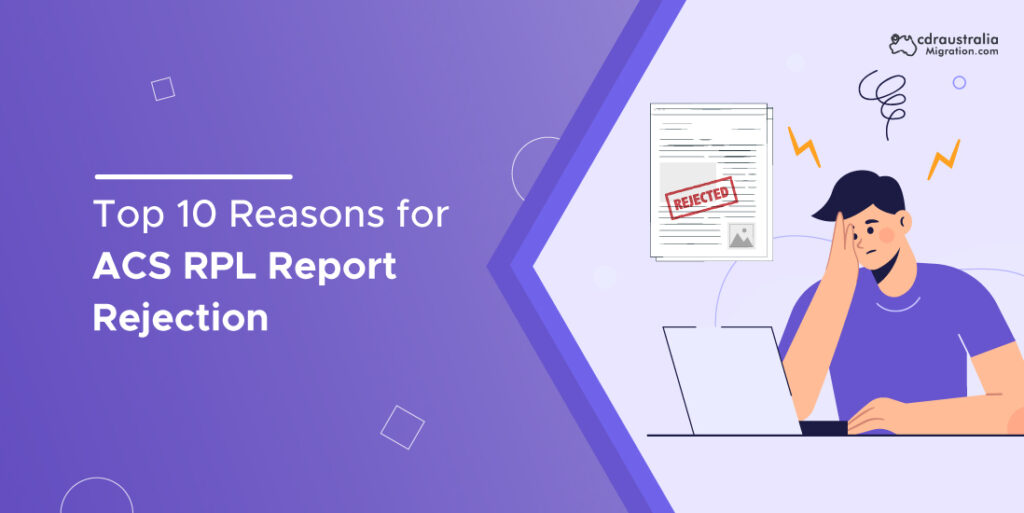All IT professionals who desire Australian migration should fully understand ACS RPL procedures. ACS demands specific employment reference letters to confirm both your workplace experience and IT abilities. A properly written reference letter will boost your chances of achieving success in the ACS skills evaluation, which will lead to the acceptance of your migration applications.
This guide provides detailed information about creating the ultimate employment reference letter that will support ACS RPL reports.
🔑 Key Highlights
- Importance: Your applications for an ACS RPL require an employment reference letter that verifies your ICT work background.
- The reference document must detail the job title and specific responsibilities while listing utilised technologies and work duration, which serves to authenticate your ability for skilled immigration.
What is an ACS RPL Report?
The ACS RPL (Recognition of Prior Learning) report addresses IT professionals whose educational qualifications are either nonexistent or unrelated to their professional work experience. The system enables workers to showcase their acquired expertise from professional practice.
Who Needs an ACS RPL Report?
Individuals without an ICT degree or relevant qualification.
Workers in the ICT sector can use the RPL report to showcase their knowledge even though they do not possess official credentials.
Skilled migrants who want to live in Australia under ICT professions must submit this application.
The RPL report consists of two major sections, which must be completed by the candidate.
The sections display the test-taker’s mastery of the ICT subject matter.
Three key elements of the RPL report system include key areas of knowledge and two project reports with case study applications.
Importance of an Employment Reference Letter in ACS RPL

The ACS RPL (Recognition of Prior Learning) application requires employment reference letters to serve as a fundamental part. The Australian Computer Society (ACS) employs this document to validate both your working experience and technical abilities during skill assessments for migration purposes. ACS bases its assessment on real-world Information and Communication Technology (ICT) practice, therefore making the reference letter essential.
1. Proof of Work Experience
Professional experience in the ICT sector needs concrete evidence for ACS applications according to their requirement. The employment reference letter serves to demonstrate your professional history of performing tasks that match your selected occupation to immigration assessing bodies. The absence of this document leads to application denial from ACS because of inadequate proof.
2. Verification of Skills and Competencies
During the assessment process, ACS examines your skill level through evaluation of your work duties and the technical tools you handled in prior positions. The written reference contains detailed descriptions of your work duties and technology-related skills, which you successfully performed. The reference letter allows ACS to validate that your qualifications match those required by your profession according to established standards.
3. Authenticity of Your Claim
ACS operates with great strictness regarding the verification process for authenticating work experience claims. A reference letter signed by a representative such as a manager or human resources personnel gives strength to the statements made in your application. The official validation process protects your application from being marked as suspicious or being questioned by ACS.
4. Demonstrates Practical Application of Knowledge
The ACS RPL procedure targets people without a standard ICT educational background. The reference letter is essential for proving that your practical work experience makes up for your unidentified academic background. Your presentation of practical work and problem-solving abilities and detailed projects demonstrates your suitability for the nominated position at ACS.
5. Clarification of Employment Duration
Each employment duration must be precisely stated according to the ACS requirements. The reference letter should display the full employment period using a standardised date format (DD/MM/YYYY). The length of time between your start and finish at each job will determine the number of relevant years ACS uses for work experience qualification verification.
6. Highlights Specific Projects and Achievements
For your application it helps to include full descriptions about projects both as a manager and as a contributor. The technical competencies you used while working on actual projects must be showcased to ACS through your submission. Your application benefits from highlighting achievements that include heading a team or developing essential systems because it proves your positive organisational influence.
7. Demonstrates Professionalism and Authenticity
The reference letter needs professional formatting while containing a structured format according to ACS standards, which should appear on company letterhead, be accompanied by an official stamp and be signed by the writer. The serious nature of your application becomes evident through this document presentation. The letter needs to remain truthful because any untrue statements might result in the denial of your assessment process.
8. Supports the RPL Project Reports
The RPL submission includes reference letters together with project reports. Project reports deliver detailed case studies, but the reference letter supplements them by concisely describing your job responsibilities and accomplishments. ACS receives a unified understanding of your professional potential through the combination of your practical work and professional experience.
Key Elements of a Perfect Employment Reference Letter

1. Personal and Professional Information
This initial part provides fundamental identification information for both workers and employers. You must provide exact, precise information.
What to Include:
- Your Full Name: As per your official records.
- The organisation’s official title appears as Employer’s Name followed by its complete formal name.
- The organisation maintains its official postal address, which comprises city state and country.
- Your Position: Mention your job title (e.g., Software Engineer, IT Analyst).
- The document requires your phone number and your email while including the employer’s official contact information.
2. Employment Duration and Job Roles
The section shows your time at the organisation with details on your work type.
What to Include:
- Enter employment dates in DD/MM/YYYY format since it reduces misunderstandings.
- State if you worked full-time or part-time employment to clarify your working schedule.
- The total length of work experience consists of combined years and months.
- The employment arrangement included describing its nature between full-time, contractual and freelance work.
3. Detailed Job Description
The central part of your employment reference letter consists of this section. The description should outline all your activities at work, together with your organisational duties and job responsibilities.
What to Include:
- The first section should concentrate on core duties where you mentioned your responsibilities, including software development and system analysis alongside network management.
- The included technical requirements should detail all applied technologies and programming languages and embrace specific tools that you utilised.
- Please briefly list the major projects you led during your work period.
- Your team leadership status and whether you pursued independent work should be noted.
- Include problem-solving experiences that showcase your abilities in leadership roles.
- Measurable achievements should be listed with specific metrics, such as “the system performance improved through 20% system enhancing.
4. Skill Sets and Competencies Demonstrated
You demonstrate your skills and professional abilities by showing ACS how you used them in actual workplace scenarios according to this section.
What to Include:
- Professional competencies should include an enumeration of programming languages together with the tools and systems you frequently apply in your work.
- Soft Skills: Mention skills like teamwork, problem-solving, leadership, or client communication.
- Certifications (if applicable): Include any certifications relevant to your role.
- Your profile should include specific details about the technical abilities that match your occupation, either through software debugging, system maintenance or network security practices.
5. Technologies Used
Provide specific details about the technologies, together with frameworks and software products, you handled specifically for your occupational responsibilities.
What to Include:
- The stack of programming languages I use includes Java, C++, and Python, together with numerous others.
- Frameworks and Libraries: Angular, React, Django.
- Databases: SQL Server, MySQL, MongoDB.
- Software Tools: JIRA, Git, Docker.
- Operating Systems: Windows, Linux, macOS.
6. Accomplishments and Contributions
Present your accomplishments over job responsibilities because this demonstrates how you added value to the organisation.
What to Include:
- Quantifiable Achievements: “Reduced server downtime by 40% through optimisation.”
- The reference lists all awards together with the received acknowledgments.
- Project Success contains a description of key project finishes that matter.
- The letter demonstrates how specific achievements from your work resulted in profitable outcomes for the company.
7. Signature and Verification Details
This final part authenticates the reference letter. An authorised organisational personnel member needs to sign the document.
What to Include:
- The person who signed the letter must provide their name and title together with their contact details.
- Signature: A handwritten signature of the supervisor or HR manager.
- An official stamp named Company Stamp provides authentication certification.
- The letter emerged on a specified date.
Steps to Write a Perfect Employment Reference Letter for ACS RPL Reports

Step 1: Gather Necessary Information
Your first task for writing the letter requires you to collect every essential piece of information. Your letter requires information about your job titles together with employment periods as well as project work examples and technology platforms you implemented.
The basis of your letter depends on having exact information and complete details. Ensure the information collection process includes validation of timeline details and work duties for maintaining consistent documentation.
Step 2: Structure the Letter
The second phase requires you to arrange your letter content professionally. The first section, comprising the header, demonstrates authenticity through its inclusion of the company logo and address. Use a proper greeting at the start that targets the Australian Computer Society (ACS) or the appropriate authority.
The professional experience description should be explained extensively in the letter’s main text section. Describe all roles you had in your position with specific responsibilities you handled backed by your professional accomplishments. Details regarding your completed projects, together with details about specific skills and technological expertise from your professional period, should be provided.
End the letter by strengthening your qualifications alongside your offer to share additional information upon request. Address your request to your supervisor to sign the document before we finalise it with the official company stamp.
Step 3: Writing Tips
The preparation of the letter requires both clarity and precision during writing. Rephrase the essential information that demonstrates your professional skills and employment background using clear language throughout the text. The document requires professional language, which should be maintained for its entirety.
Technical language, along with specialised terms, should be omitted because it creates understanding issues for readers. Simple, direct language represents the preferred approach when preparing documentation. Job description entries, along with dates, must display perfect accuracy and consistency to establish credibility in the document.
Conclusion
The employment reference letter serves as an essential document when preparing your Australian Computer Society (ACS) Recognition of Prior Learning (RPL) report. This necessary document shows evidence of your professional experience combined with your skills and area of expertise. A skilled reference letter plays an important part in ACS skills assessment outcomes because it demonstrates your fit for the occupational standards during evaluation.
Your reference letter should have a strong impact when it presents accurate information in a relevant manner while maintaining authenticity. The accuracy of your application depends on precision because errors can destroy the trustworthiness of your submission.
The information needs a direct connection to both the position you apply for and the skills that assessment authorities will evaluate. The Australian Computer Society requires authentic information, especially because they use only verified and truthful data. A signature from the supervisor combined with an official company stamp strengthens the authenticity of the letter.
FAQs
1. How do you write a good employment reference letter?
Writing an excellent employee reference letter requires a beginning section that explains the context and then lists the employee position before specialising their abilities with concrete illustrations while using formal language to create a strong closing statement.
2. What is the employment reference letter for Australian immigration?
Employment reference letters for Australian immigration serve to authenticate work experience alongside job responsibilities, skills and duration of employment provided by an applicant to an Australian immigration authority.
3. How does ACS verify employment?
ACS verifies employment by performing document examination while making direct calls to employers and validating claims against different records.



